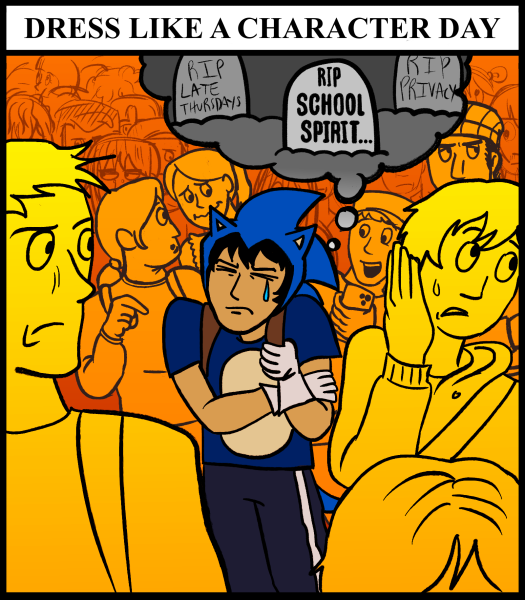YouTube Red presents new challenges
Online community faces controversy with video spin off
April 26, 2016
What happens when something that’s been free for a decade is suddenly, well, not? Overwhelming controversy, evidently. Late last year YouTube launched YouTube Red, a paid monthly subscription service that seemingly offers many benefits, but has sparked more opposition than it has support.
Let’s start with the facts. YouTube Red costs $10 per month, and removes advertisements from all videos (though it’s worth noting that this does not apply to paid YouTube content, such as paid channels and TV and movie rentals). It’s available on a wide variety of devices such as Chromecast, Apple TV, Xbox and Playstation.
The service also provides two other benefits: offline viewing and listening to videos while the screen is off. With offline viewing, you can download any video to your device and, for up to 30 days, watch it without an internet connection.
Finally, subscribers to YouTube Red also get a free Google Play Music subscription, which also works inversely. If you already pay for a Google Play Music subscription, you are given access to YouTube Red for free.
Continually, one of the more advertised benefits are the original shows exclusive to the paid service. This includes “Scare Pewdiepie,” a reality series which puts Felix Kjellberg (a.k.a. Pewdiepie) into live horror situations inspired by video games, “Lazer Team,” a feature-length sci-fi action-comedy film from Rooster Teeth, one of YouTube’s oldest gaming and entertainment production companies, and “A Trip to Unicorn Island,” a movie which follows Lilly Singh (a.k.a. IISuperwomanII) on her world tour.
Possibly the most controversial aspect of this new service is what Google is doing to those who don’t sign on. Specifically, all partnered content creators who collect ad revenue from their videos must sign YouTube’s revenue share deal, or all of their videos will be made private by Google.
Several months ago, ESPN had to remove the majority of its videos from all versions of YouTube in the U.S. when they were unable to join the subscription service.
Now that the facts are out of the way, and you’re up to speed, it’s time to pro-con this whole “paid monthly service” thing. On the pro side, many of us are wildly impatient, so the ad removal is definitely a plus. Offline viewing is something that has generally been in demand for a while, putting that pretty high up on the positive side.
While the benefit of being able to listen to videos while your screen is off may be something others would consider a great improvement, I’d rather consider it mostly a non-factor. The overwhelming majority of YouTube videos are visual entertainment, apart from music videos or podcasts which generally are a small percentage of all content on the website.
Moving on to the negatives, I can clearly see several. First off, YouTube has been free for everyone since its very creation. To now tell people they have to pay for what they’d normally get for free is perhaps not the best course of action for Google.
I’m not dismissing the fact that it’s optional, and everything else is still free, but the very act of changing the way things are automatically incites resistance and opposition. This is just general human nature.
While I don’t doubt that some of these original shows and specialty content that’s exclusive to YouTube Red is worthy and deserving of being paid for (“Lazer Team” has been in production since as early as 2010), this is a system that can easily be abused.
Content creators who don’t necessarily have “quality content,” can sign on to YouTube Red and force subscribers to pay up if they want to see their content. It’s a potentially easy way for those who don’t produce great videos to increase their profits while still not working very hard or making content worth paying a dime for.
Inversely, this paid subscription could have an adverse effect on perfectly good, quality content creators. Creators who sign on to YouTube Red could lose much of their subscriber base just by making the decision to join the service, due to the vast number of people who strongly oppose Red.
Many will unsubscribe solely on principle, just because they’re opposed to YouTube Red. Perhaps they believe it would be hypocritical of them to hate the service but be subscribed to a YouTuber who uses said service.
The final con honestly needs next to no explanation or defense. Google making the videos of those who do not sign their so-called “revenue share deal” is the equivalent of a 12th grade bully beating the snot out of defenseless freshmen who refuse to hand over their lunch money.
This is Google essentially Godfather-ing content creators, making them an offer they really can’t refuse.
In any case, opinions will continue to differ, and those in the YouTube community will continue to debate the issue far into the foreseeable future.
Whether or not Google had purely good intentions when launching YouTube Red, I couldn’t say. But when it comes right down to it, I believe we can all agree that in its execution and implementation, the multi-billion dollar behemoth of a company was far from perfect.



